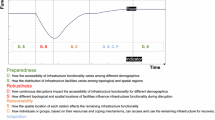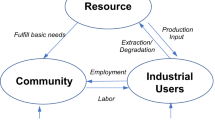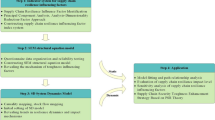Abstract
We describe a framework for understanding the factors that underpin economic resilience, and identify the basic tools for implementing it. This principally involves examining resilience by design, which promotes endogenous reorganization in the economy, and by intervention, which includes exogenous measures such as bailouts, stockpiles and building buffers. We link these ideas to comparable notions from physics, such as the rich and non-trivial phenomenology that arises in circumstances when a system is dynamic and out of equilibrium. We contend that a more nuanced understanding of the underlying structure of our economic system could lead to more enlightened policy decisions that promote resilience and result in better outcomes in the long run.
This is a preview of subscription content, access via your institution
Access options
Access Nature and 54 other Nature Portfolio journals
Get Nature+, our best-value online-access subscription
$32.99 / 30 days
cancel any time
Subscribe to this journal
Receive 12 print issues and online access
$259.00 per year
only $21.58 per issue
Buy this article
- Purchase on SpringerLink
- Instant access to full article PDF
Prices may be subject to local taxes which are calculated during checkout
Similar content being viewed by others
References
Anderson, P. W. More is different. Science 177, 393–396 (1972).
Föllmer, H. Random economies with many interacting agents. J. Math. Econ. 1, 51–62 (1974).
Kirman, A. in OECD Complexity and Policymaking (OECD, 2016).
Linkov, I., Keenan, J. & Trump, B. D. COVID-19: Systemic Risk and Resilience (Springer, 2021).
Trump, B. T., Hynes, W. & Linkov, I. Combine efficiency and resilience in post-COVID societies. Nature 588, 220 (2020).
Linkov, I., Trump, B. D., Golan, M. & Keisler, J. Enhancing resilience in post-COVID societies: by design or by intervention? Environ. Sci. Technol. 55, 4202–4204 (2021).
Kott, A. S., Golan, M. S., Trump, B. D. & Linkov, I. Cyber resilience: by design or by intervention? Computer 54, 112–117 (2021).
Simmie, J. & Martin, R. The economic resilience of regions: towards an evolutionary approach. Camb. J. Reg. Econ. Soc. 3, 27–43 (2010).
Sonnenschein, H. Market excess demand functions. Econometrica 40, 549–563 (1972).
Mantel, R. On the characterisation of aggregate excess demand. J. Econ. Theory 7, 348–353 (1974).
Debreu, G. Excess demand functions. J. Math. Econ. 1, 15–23 (1974).
Beaudry, P., Galizia, D. & Portier, F. Reviving the Limit Cycle View of Macroeconomic Fluctuations (NBER, 2015).
Portier, F. The instability of market economies. Rev. OFCE 157, 225–233 (2018).
Gabaix, X. The granular origins of aggregate fluctuations. Econometrica 79, 733–772 (2011).
Bak, P., Chen, K., Scheinkman, J. & Woodford, M. Aggregate fluctuations from independent sectoral shocks: self-organized criticality in a model of production and inventory dynamics. Ric. Econ. 47, 3–30 (1993).
Scheinkman, J. & Woodford, M. Self-organised criticality and economic fluctuations. Am. Econ. Rev. 84, 417–421 (1994).
Guzman, M. & Stiglitz, J. E. Towards a Dynamic Disequilibrium Theory with Randomness Working Paper No. w27453 (NBER, 2020).
Juncker, J.-C., Tusk, D., Dijsselbloem, J., Draghi, M. & Schulz, M. The Five Presidents’ Report: Completing Europe’s Economic and Monetary Union (European Commission, 2015); https://ec.europa.eu/info/publications/five-presidents-report-completing-europes-economic-and-monetary-union_en
Sondermann, D. Towards more resilient economies: the role of well-functioning economic structures. J. Policy Model. 40, 97–117 (2018).
Weil, D. The Fissured Workplace (Harvard Univ. Press, 2017).
Shiller, R. Irrational Exuberance (Princeton Univ. Press, 2000).
Pfeffer, J. & Williams, L. Mental health in the workplace: the coming revolution. McKinsey Quarterly (8 December 2020); https://www.mckinsey.com/industries/healthcare-systems-and-services/our-insights/mental-health-in-the-workplace-the-coming-revolution
Smith, E. et al. A brain capital grand strategy: toward economic re-imagination. Mol. Psychiatr. 26, 3–22 (2021).
Haldane, A. Rethinking the Financial Network (2009).
Hynes, W., Trump, B., Love, P. & Linkov, I. Bouncing forward: a resilience approach to dealing with COVID-19 and future systemic shocks. Environ. Syst. Decis. 25, 1–11 (2020).
Author information
Authors and Affiliations
Corresponding author
Ethics declarations
Competing interests
The authors declare no competing interests.
Additional information
Publisher’s note Springer Nature remains neutral with regard to jurisdictional claims in published maps and institutional affiliations.
Rights and permissions
About this article
Cite this article
Hynes, W., Trump, B.D., Kirman, A. et al. Systemic resilience in economics. Nat. Phys. 18, 381–384 (2022). https://doi.org/10.1038/s41567-022-01581-4
Received:
Accepted:
Published:
Issue date:
DOI: https://doi.org/10.1038/s41567-022-01581-4
This article is cited by
-
Evaluation of REITs resilience of infrastructure projects from the perspective of investor heterogeneity based on Geodetector Models——Empirical data from China
Frontiers of Engineering Management (2025)
-
Exploring Stakeholder Preferences in Evaluation of Resilience Strategies for Post-mining Transformation Projects
Mining, Metallurgy & Exploration (2025)
-
The delayed era of network economics: ongoing opportunities for dynamic socio-economic network models
Discover Networks (2025)
-
An index of static resilience in interindustry economics
Journal of Economic Structures (2024)
-
Resilience and lessons learned from COVID-19 emergency response
Environment Systems and Decisions (2022)



